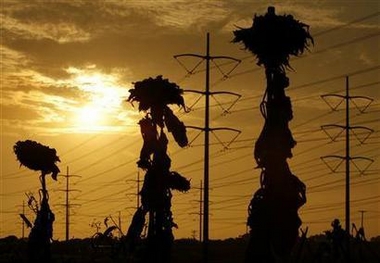Gripped by a 10th straight day of 100-degree heat, California sweated out the
possibility of more blackouts Tuesday as the number of suspected heat-related
deaths climbed to at least 56 and the rotting carcasses of thousands of dairy
cows and other livestock baked in the sun.

Withered sunflowers
are silhouetted next to power lines in Carlsbad California as a heat wave
strains the state's power grid, July 24, 2006.
[Reuters] |
Some communities faced their third day without electricity as the
record-breaking temperatures strained transmission equipment.
"We're asking people for one more day of conservation," said Gregg Fishman,
the California Independent System Operator, which manages the state's power
grid. "We're not out of the woods yet."
The stretch of 100-plus degree scorchers that descended on the state last
week marks the first time in 57 years that both Northern and Southern California
have experienced extended heat waves simultaneously, California Undersecretary
for Energy Affairs Joe Desmond said.
In the Central Valley, where most of the deaths have occurred, temperatures
were expected to reach 100 to 105 degrees on Tuesday, down from 110 to 115 in
previous days. Truly cooler weather was not expected until Wednesday, when the
system was forecast to move east into Nevada and Utah.
Coroners in 14 counties were investigating deaths that appeared heat-related.
Most of the victims were elderly. Among the dead was a nursing home patient in
Stockton who died after the air conditioning gave out in 115-degree weather. A
gardener collapsed on the job and died. A woman was found dead along a bike
path.
On Tuesday, three elderly residents of single-room occupancy hotels within
four blocks of the state Capitol were found dead. The rooms had no air
conditioning.
The heat has been hard on livestock as well, causing thousands of deaths and
a dip in milk production in California, the No. 1 dairy state, according to
agriculture officials.
In the San Joaquin Valley, a combination of the searing heat, bigger dairies
and fewer plants to properly dispose of dead animals created a backlog of
rotting carcasses.
"They're just sitting out there in the sun, drawing flies," said Fresno
County dairy farmer Brian Pacheco.
Tens of thousands of customers in Northern and Southern California had no
electricity. About 1,700 San Jose customers faced their third day without power,
and some residents slept in backyards and hotel rooms to escape the stifling
heat.
Pacific Gas & Electric spokesman Brian Swanson said most outages were
caused by equipment failures and not a shortage of electricity.
In St. Louis, about 145,000 homes and businesses still without power after
two storms last week knocked out electricity to nearly 600,000 customers. A
utility worker was electrocuted Tuesday and another was injured while trying to
restore power.
Many grew frustrated with Ameren Corp.'s handling of the crisis. The Rev. Al
Sharpton led a protest Tuesday in front of Ameren headquarters, saying the
company was not doing enough to help poor and working-class people. The civil
rights activist also called for a 10 percent rate cut to help the community
recover.
Ameren officials have said the company responded within 15 minutes after the
storm hit.
In New York City, a blackout that left about 100,000 people without
electricity during some of the hottest days of the year all but ended Tuesday,
allowing weary residents who endured nine days of rotting food and sweltering
homes to begin getting back to normal.
Consolidated Edison said fewer than 500 people remained without electricity
in the borough of Queens as of Tuesday evening.
Meanwhile, the first lawsuit against the utility over the blackout emerged
Tuesday, and the City Council said it would hold its first hearing on the
outages Thursday. Utility spokesman Chris Olert declined to comment on the suit.
In the suit, Sandra Boyle said her 2-year-old child became ill and she
couldn't get in touch with a doctor for hours because she had no power. She is
seeking unspecified damages for emotional and physical distress.
"If it was only me and my husband, I wouldn't be here," she said. "I'm very
fed up with the whole thing. In this day and age ¡ª it's not a third-world
country that we live in."
Elswhere, a 51-year-old woman collapsed and died of heat stroke Monday while
walking on a dirt road near her home in Lindsay, Okla., authorities said
Tuesday. The temperature there had reached 95 degrees, and an autopsy showed the
woman's body temperature was 112.